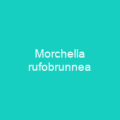Verpa bohemica: The Early Morel with a Brainy Twist
Imagine stumbling upon a mushroom that looks like it’s been sculpted by nature itself, with its wrinkled cap resembling the folds of a brain. This is Verpa bohemica, a fascinating fungus that has captivated mycologists and foragers alike.
The Name Game: Bohemia to Verpa
Verpa bohemica, once known as Morchella bohemica, was first described by Julius Vincenz von Krombholz in 1828. Later, it was transferred to the genus Verpa by Joseph Schröter in 1893. The name ‘bohemica’ refers to Bohemia (now a part of the Czech Republic), where this species was originally collected.
A Brainy Appearance: Cap and Stem
The cap of Verpa bohemica is 2-4 cm in diameter and 2-5 cm long, with a conical or bell shape. It’s covered in longitudinal ridges that fuse together into a vein-like network, giving it the appearance of a wrinkled brain. The stem can grow up to 12 cm long and varies in color from yellowish brown to reddish brown.
Spores and Growth Conditions
The spores are large, typically measuring 60-80 by 15-18 μm, and appear hyaline (translucent) to yellowish. They are elliptical, smooth, sometimes curved, and number two per ascus. The asci measure 275–350 μm long by 16–23 μm wide and are heliotropic, bending toward light. The paraphyses are thick and club-shaped, with diameters of 7–8 μm at their tips.
Distribution and Habitat
Verpa bohemica has a wide distribution throughout northern North America and Europe, often found in moist areas with ample sunlight. It prefers fruiting in early spring, particularly along riverbanks near cottonwoods, willows, and aspens. Its minimum growth temperature is 3 °C (37 °F), with an optimum of 22 °C (72 °F), and a maximum of about 30 °C (86 °F).
Ecological Role
A 10-year study in Iowa showed the distribution and habitats of morel species, including Verpa bohemica. Early false morels appear first, followed by narrow-head, yellow or white, and lastly Morchella crassipes. The fruit bodies serve as a habitat for breeding dipterans (flies).
Edibility and Caution
Is Verpa bohemica safe to eat? That’s the million-dollar question! Despite being edible, its edibility is debated due to potential toxicity. Consumption should be restricted to small portions and cooked thoroughly to test tolerance. Some advocate only eating the caps and discarding the stems.
Taste and Flavor
The flavor of Verpa bohemica varies widely, with some describing it as ‘strong but not like true morels,’ while others find it ‘pleasant’ or even ‘not distinctive.’ It’s a matter of personal taste, much like deciding whether to enjoy the complexity of a fine wine or the simplicity of a glass of water.

In conclusion, Verpa bohemica is a fascinating fungus with a unique appearance and an intriguing history. Whether you’re a seasoned mycologist or just curious about the world of mushrooms, this early morel offers a taste of nature’s complexity. So, next time you venture into the woods in spring, keep your eyes peeled for these brainy little wonders!
You want to know more about Verpa bohemica?
This page is based on the article Verpa bohemica published in Wikipedia (retrieved on November 26, 2024) and was automatically summarized using artificial intelligence.







